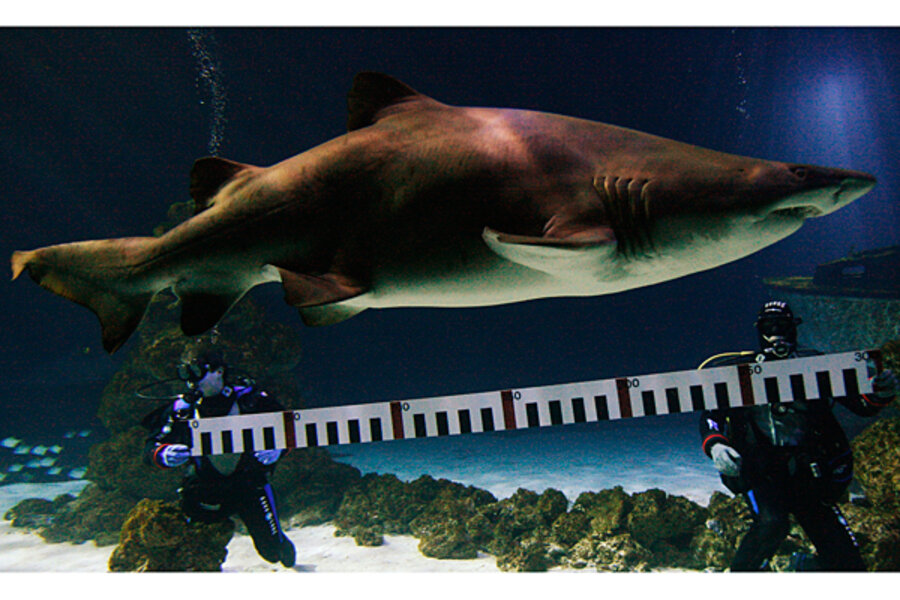Scientists unravel mystery of cannibal shark embryos
Loading...
Why do sand tiger shark embryos devour each other in the womb? A new study examines this form of extreme sibling rivalry.
Analyzing shark embryos found in dead sand tiger sharks at different stages of pregnancy, a team of researchers has found that, though female sharks commonly mate with multiple males, their offspring all tend to belong to the same father.
This finding suggests that shark embryos cannibalize their brothers from other dads, an illustration that sexual selection can still occur after fertilization.
"In some species, the struggle for paternity continues beyond the point where the female [mates with] the male," said Demian Chapman, a Stony Brook marine biologist, in an interview with LiveScience's Tia Ghose.
Sand tiger sharks, also known as sand sharks, sand tigers, or gray nurse sharks, have sharp teeth that protrude in all directions, even when they shut their mouths. Despite their fearsome name and appearance, they are known to attack humans only when provoked. Because of this, sand tigers are the most common sharks found in public aquariums.
They mature at between 6.5 and 10.5 feet. Female sand sharks have two uteri that bear hundreds of eggs. Though mating with many male sharks, every 12-month pregnancy produces just two offspring, each about 3.3 feet long.
Since the 1980s, according to Chapman, scientists examining pregnant sand tiger sharks found embryos in the stomachs of other embryos. This in utero cannibalism, taking place about five months into the gestation, allows the remaining embryo to feed itself on its siblings' bodies and the mother's nutrient supply. As a result, the baby sand tiger at birth is already big enough to protect itself from predators.
“Only really big sharks eat baby sand tigers,” Chapman told National Geographic.
What triggers the embryonic killings, however, remains unknown.
To better understand embryonic cannibalism, Chapman and his team investigated DNA specimens of pregnant sand tigers that had been caught in protective nets off Richards Bay, South Africa from 2008 to 2012.
Of 15 female sharks studied, five had six to nine embryos in each uterus, which indicated they were in the early stage of their pregnancy and the embryonic cannibalism hadn't yet occurred. The remaining sharks carried just two embryos, a sign that the competition was over.
Genetic analysis showed that those pregnant sharks were more likely to have mated with at least two males. The embryos that hadn't eaten one another were half siblings. In the remaining mothers that had only the two embryos remaining, the litters shared the same father.
Writing in Biology Letters, the authors said this result demonstrated that, despite the mothers having more than two partners, their babies are full siblings, suggesting that embryonic cannibalism helped eliminate other fathers' offspring.
“For most species, we think of sexual selection as ending when males fertilize eggs, because once the male’s fertilized eggs he’s won, there will be some genetic representation in the next generation,” Chapman told The Washington Post. “This is demonstrating that embryonic cannibalism is actually whittling down the number of males producing offspring.”
Talking to LiveScience, James J. Gelsleichter, a North Florida marine biologist who didn't participate in the study, said this study opens up to some questions, for instance, what makes one father's embryos successful over another's?
One theory is that embryos from the first male to fertilize the female simply grows bigger first, consuming other embryos.
"Sexual selection is very much like an evolutionary arms race, and the males and females are basically one-upping each other," said Gelsleichter.
While embryonic cannibalism is rare in nature, according to the study's authors, cannibalism is common in the animal kingdom.
Many animals are known to kill and eat members of their own species. For instance, tadpoles croak not only when attacked but when they cannibalize their kin.
The female praying mantis tends to eat the male after mating. And male lions sometimes kill cubs that aren't their own, to assume control of a new pride.
Scientists in 2010 suggested that the Tyrannosaurus rex may have also eaten its own kind.








